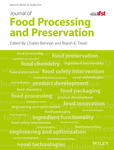Effect of thermal treatment on aroma generation from bovine bone marrow extract during enzymatic hydrolysis
Abstract
Because of less explored flavor characteristics and extensive utilization of bovine bone marrow extract (BBME) in food industry, this study was designed to focus on its flavor generation via Maillard reaction using different heating temperatures. Response surface method (RSM) was used to optimize the reaction conditions for generation of meaty flavor. Optimal conditions (time, temperature, and pH) were 1 hr, 120°C, and 4.67, respectively. Volatile and nonvolatile compounds (amino acids, nucleotides, and peptides) were identified by SPME/GC-O-MS and HPLC, respectively. The temperature (120°C) resulted in optimum Maillard reaction products (MRPs) , such as meaty aroma compounds (hexanal, nonanal, methional, 4-methyl-5-hydroxyethyl-thiazole, 2-acetylthiophene, 2-acetylfuran, etc. 302.8 ng/g) and umami taste-active compounds (umami amino acids and <1,500 Da peptide were 2.38 g/L and 80.19%, respectively). Based on our results, the temperature (120°C) is recommended for flavor generation from enzymatic hydrolysis of BBME (EH-BBME) through Maillard reaction.
Practical applications
Raw bovine bone marrow (BBM) is generated in large quantities on a daily basis. BBM is considered as low added value products, and in general the industries are putting efforts into increasing their value. While being edible, still the BBM is not used for human consumption or pet food without proper processing. However, to a large extent, BBM is an excellent source of minerals, nutritive value protein, and vitamins, hence might contribute to the increasing protein global demand. Therefore, the current study was aimed to optimize the thermal reaction conditions that enhance the flavor generation from BBM extracts, and in turn will improve meat industry profitability, sustainability, and better utilization of available resources.
CONFLICT OF INTEREST
The authors have declared no conflicts of interest for this article.




